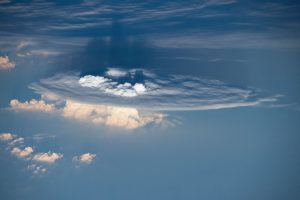
A sudden warming event high in the stratosphere that is threatening to reverse a major air current found in that layer of the atmosphere has occurred, a reversal that, in turn, runs a high probability of disrupting the air currents that contain the polar vortex that circles the Arctic, something that would cause cold Arctic air to flow into lower latitudes and bring frigid weather conditions to typically warmer regions further south.
This event, called sudden stratospheric warming (SSW), saw temperatures at an altitude of 30,500 meters (100,000 feet) jump more than 20 degrees Celsius (36°F), from roughly -50°C up to -30°C in the week between February 7 and 15. This warming is typically accompanied by a reversal of the associated polar air currents circling the globe at high altitudes, changing their westerly direction to an easterly one. SSW events are estimated to occur once every few years, although the effect has only been observed by scientists over the last two cycles.
Although this is an event that is taking place in the stratospheric polar vortex, it’s important to note that this is not the tropospheric polar vortex typically referred to by meteorologists, although changes in the upper air mass tend to affect its lower-altitude counterpart.
Although we tend to refer to the (tropospheric) polar vortex as a singular phenomenon, the Earth actually has two such air masses, one surrounding the poles in each hemisphere, and with the exception of Venus all of the planetary bodies in the Solar System with an atmosphere have the same feature, such as the one bordered by the peculiar hexagonal air current circling Saturn’s north pole.
These polar vortices typically orbit their respective poles in a more-or-less circular fashion, held in place by the temperature differential found between the higher and lower latitudes, with each vortex’s edge defined by the high-speed air current known as the jet stream.
However, when the atmosphere warms, as is currently happening with global warming, the polar amplification effect causes the excess heat energy to migrate to the poles, and that increase in temperature in the high latitudes lessens that region’s difference to the temperatures further south, causing the jet stream to meander. This wandering of the polar vortex’s boundary displaces Arctic air southward via the vortex’s lobes, causing unusually cold weather at typically warm latitudes, such as the freezing event experienced in Texas in February 2021.
These large-scale weather patterns take place in the troposphere, the atmospheric layer that extends from the surface up to 17 kilometers (11 miles or 56,000 feet) at the middle latitudes; the SSW event takes place in the next layer up—the stratosphere—of which extends up to an average altitude of 50 kilometers (31 miles or 164,000 feet).
Roughly once every two years the energy from large-scale atmospheric oscillations called Rossby waves that are generated in the troposphere finds its way into the stratosphere where it disrupts the stratospheric polar vortex, causing it to slow and reverse direction, causing a warming effect at that altitude.
This reversal causes the stratospheric winds to extend down into the troposphere, disrupting and slowing the air currents of that layer, such as the polar vortex-bounding jet stream, in turn causing those currents to wander from their usual courses, resulting in extreme weather effects such as the aforementioned disruption of the tropospheric polar vortex.
However, the effects from a SSW can take some time to be felt at lower altitudes: in an entry on blog.weather.us, meteorologist Armando Salvadore explains that this delay “typically takes weeks for our sensible weather patterns to be impacted (usually up to 60 days post disruption).”
The disruptive effects from this event are also not guaranteed: because study of the phenomenon is also relatively new, Salvadore points out that there “is that there is a great deal of uncertainty and variation in what exactly happens following these events,” meaning that what this sudden stratospheric event has in store for us remains to be seen.
Subscribers, to watch the subscriber version of the video, first log in then click on Dreamland Subscriber-Only Video Podcast link.
I am sorry to say that I need to cancel my subscription temporarily and cannot find a place to do that, Hence I am writing it here. I love Whitley and his show and the books so that is not the issue. Circumstances ares such that my time is stretched right now and I am lucky to have time in a month to catch the podcast once. Later on I will resign my subscription, but for now please cancel. Kathy Leckie
Sounds like the story from MOK where high surface temps created a condition that caused a downdraft of extremely cold air. If memory serves this is not quite what he described but still???